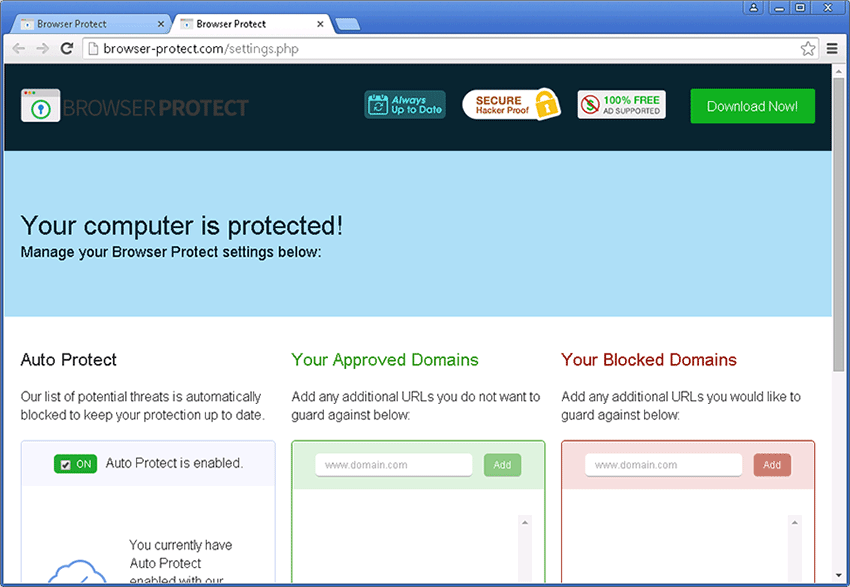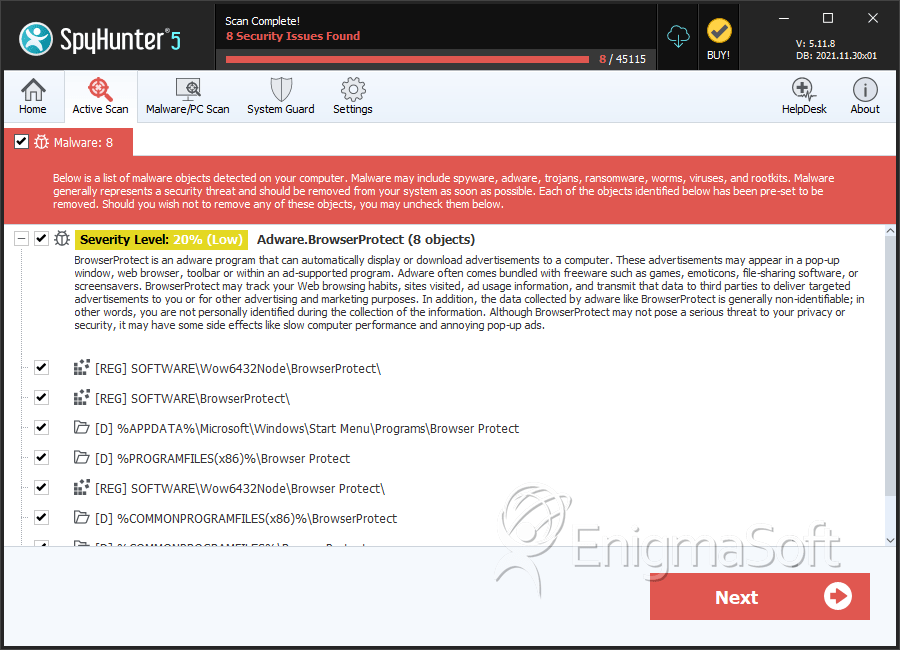BrowserProtect
Threat Scorecard
EnigmaSoft Threat Scorecard
EnigmaSoft Threat Scorecards are assessment reports for different malware threats which have been collected and analyzed by our research team. EnigmaSoft Threat Scorecards evaluate and rank threats using several metrics including real-world and potential risk factors, trends, frequency, prevalence, and persistence. EnigmaSoft Threat Scorecards are updated regularly based on our research data and metrics and are useful for a wide range of computer users, from end users seeking solutions to remove malware from their systems to security experts analyzing threats.
EnigmaSoft Threat Scorecards display a variety of useful information, including:
Ranking: The ranking of a particular threat in EnigmaSoft’s Threat Database.
Severity Level: The determined severity level of an object, represented numerically, based on our risk modeling process and research, as explained in our Threat Assessment Criteria.
Infected Computers: The number of confirmed and suspected cases of a particular threat detected on infected computers as reported by SpyHunter.
See also Threat Assessment Criteria.
| Ranking: | 6,591 |
| Threat Level: | 20 % (Normal) |
| Infected Computers: | 8,587 |
| First Seen: | June 6, 2013 |
| Last Seen: | September 10, 2023 |
| OS(es) Affected: | Windows |

BrowserProtect Image
If your security software is indicating a BrowserProtect infection in your computer, this means that a PUP, or Potentially Unwanted Program, has been detected on your computer. There are several types of PUPs, all characterized by the fact that they are not outright malicious but may cause various problematic symptoms on the infected computer. PUPs may include adware infections, suspicious browser extensions, low quality toolbars, browser hijackers and a variety of other problematic programs. If your security software indicates a BrowserProtect infection in your computer, it is important to take action immediately. While not malicious, BrowserProtect infections may expose your computer to more dangerous malware or to scams that can compromise your privacy and computer's security.
Table of Contents
The Harmful Actions Performed by BrowserProtect
Technically, BrowserProtect is not malicious. However, BrowserProtect will usually contain characteristics that are more commonly associated with malware. For example, BrowserProtect may cause browser redirects, prevent its own removal, block other programs or carry out a variety of other harmful tasks in the infected computer. Most BrowserProtect infections are used to generate advertising revenue, forcing computer users to visit websites containing advertisements and affiliate marketing links. This is often done by causing browser redirects, changing the victim's homepage and default websites, or forcing the infected Web browser to display pop-up advertisements. Dealing with a BrowserProtect infeciton usually requires uninstalling any browser extensions or other suspicious software installed recently. Once this has been done, ESG malware researchers recommend the use of a reliable anti-malware application to ensure that no malware has been acquired as a consequence of the BrowserProtect infection.
How BrowserProtect Infections Are Acquired
BrowserProtect infections are often bundled along with freeware programs from dubious sources. In many cases, these are legitimate applications that have been bundled with a BrowserProtect infection by a third party and distributed through low quality download sites. In many cases, it is possible to avoid installing these types of programs, but it usually requires opting out of this option during the installation process. One good way of preventing this from happening is by using custom installation when installing new software. This allows computer users to detect all components that are being installed and to ensure that a BrowserProtect infection is not included in the installation process. ESG malware analysts also strongly recommend installing all software carefully, following every step of the process carefully to prevent BrowserProtect infections.
SpyHunter Detects & Remove BrowserProtect

Registry Details
Directories
BrowserProtect may create the following directory or directories:
| %APPDATA%\Microsoft\Windows\Start Menu\Programs\Browser Protect |
| %COMMONPROGRAMFILES%\BrowserProtect |
| %COMMONPROGRAMFILES(x86)%\BrowserProtect |
| %PROGRAMFILES%\Browser Protect |
| %PROGRAMFILES(x86)%\Browser Protect |


Submit Comment
Please DO NOT use this comment system for support or billing questions. For SpyHunter technical support requests, please contact our technical support team directly by opening a customer support ticket via your SpyHunter. For billing issues, please refer to our "Billing Questions or Problems?" page. For general inquiries (complaints, legal, press, marketing, copyright), visit our "Inquiries and Feedback" page.